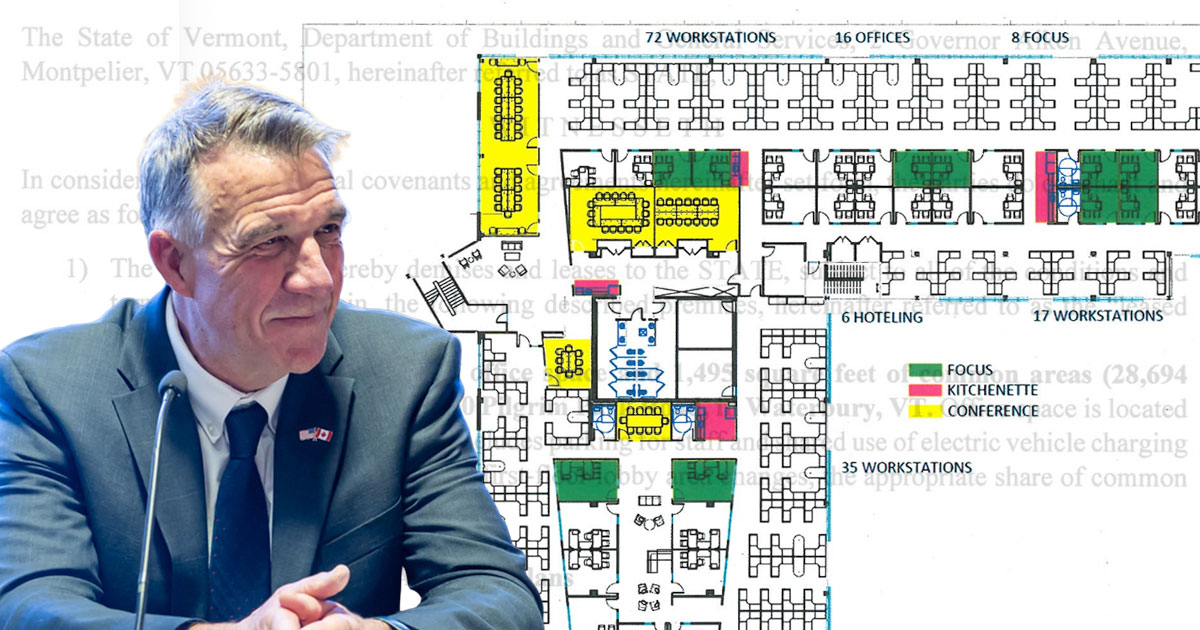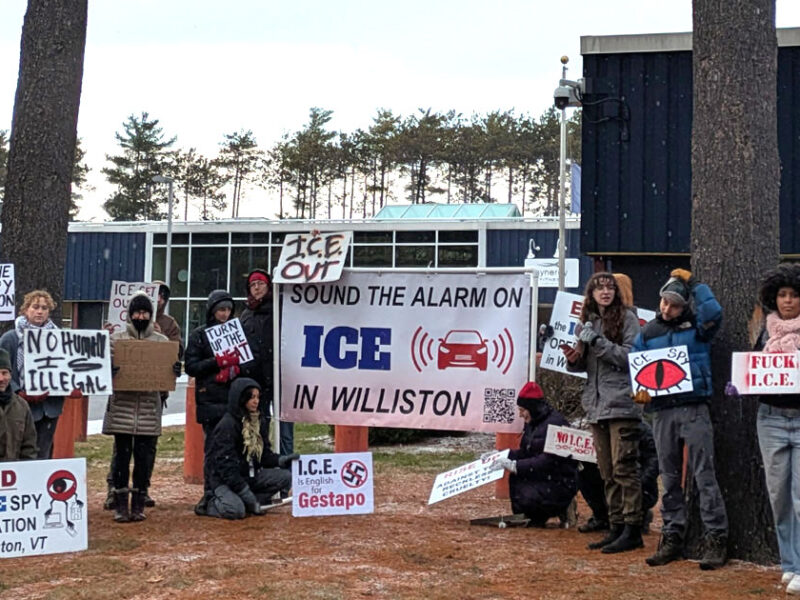When Vermont Governor Phil Scott announced in August that, starting December 1, all Vermont State employees would be required to return to the office at least three days a week, it sparked a chain of pushback by Vermont state workers. The decision will cost state employees thousands of dollars more per year, and the state will incur millions of dollars in costs for retraining, upgrading offices, and renting privately owned commercial space. In contrast to previous norms, where state agencies have been spread out throughout the state, particularly in Chittenden County, which has a much healthier supply of office space for rent, the Governor is forcing employees to relocate to Waterbury, which has limited office space options. There’s one group of people who are guaranteed to benefit from the state’s return to office mandate: Scott’s close friend, Wayne Lamberton, and his co-owners at Superior Development/Malone Clay Point Properties. Recently announced lease agreements reveal Lamberton and company will earn over $400,000 per year in state dollars as part of Scott’s demand that workers return to the office.
Doing Business with an Old Friend
Lamberton, a real estate developer who owns numerous commercial office buildings, has seen his business benefit from state leases during Scott’s tenure. Previously, the state leased 28,000 square feet of space in Waterbury at the Pilgrim Park Road office and warehouse complex, which Lamberton owns. That complex housed the Department of Children and Families (DCF) and the Department of Vermont Health Access (DVHA). The lease was canceled in 2020 due to the COVID-19 pandemic. According to new lease agreements signed for the return-to-office mandate, just over 21,000 square feet of space at the Pilgrim Park complex will be rented across three floors in two buildings.
Under the terms of the 2020 lease [PDF], Lamberton’s business was set to earn $18.77 per square foot for the 2025-26 fiscal year. With the 2025 lease, set to pay out around $430,000 for 21,660 square feet of space, it equates to $19.85 per square foot, representing a 4% increase. According to the 2020 lease agreements, a 10-year lease saw annual lease rates increase by an average of 2% over the 10-year period. Projecting out at a similar rate, a personal friend of the governor and his business partners will pocket around $2.2 million in a five-year period. In a year when commercial office spaces reached record-high vacancies nationally, this represents a fortuitous windfall for Lamberton and his business associates.
In 2018, a legislative report revealed that the state was spending $7 million annually on private landlords, including many of the state’s top commercial property owners. Historically, government leases at the state and federal levels have undergone a bidding process to ensure that no conflicts of interest arise, as multiple companies or commercial real estate holding firms have the opportunity to vie for a government contract or lease. In the case of the Pilgrim Park space procured to meet the demands of the return-to-office edict, it appears Lamberton and associates did not undergo such a process for this new lease, and any information about this has been heavily guarded in secrecy.
It’s not the first time a Lamberton-owned company has benefited from a state contract. Lamberton is also the owner of Maplewood Ltd. (not to be confused with Maplefields), which operates a large, state-promoted convenience store and a public/private 24-hour rest area that opened in 2014, located off Interstate 89 in Berlin. The deal, which was made under former Governor Peter Shumlin, was controversial, as the state placed advertisements along I-89 for its opening, a move that critics called state promotion of a private business and in violation of Vermont’s billboard ban.
From the politics to the personal, four years later, Lamberton would become a vice president at DuBois Construction, Scott’s former business. Scott reluctantly sold his 50% stake back to the company after being elected Governor, in an attempt to avoid the appearance of a conflict of interest. Yet the deal, which would pay Scott $2.5 million plus 3% interest over 15 years, was criticized by some politicians and journalists as a conflict of interest. Critics argued that Scott’s self-financing of the deal still allowed him to have a continued stake and vested interest in the company, which continued to win state contracts during Scott’s tenure as lieutenant governor and governor. This conflict of interest and ethics violation would later be confirmed in 2018 by the Vermont State Ethics Commission, which follows a narrow definition regarding conflicts of interest. It withdrew its opinion a year later, not on the merits, but on procedural grounds.
By 2022, DuBois Construction had been sold to Barrett Trucking, just under the deadline of the original terms of sale, in which DuBois was required to pay Scott both the principal and interest that he was owed. While a Scott spokesperson told VTDigger that the debt would remain the responsibility of the DuBois’ owners who originally brokered the deal, Lamberton told the publication, when asked if Scott would receive a lump sum payment of the remaining debt from the sale, “Everything would be satisfied.”
In 2024, Lamberton personally contributed the maximum $4,000 to Scott’s reelection campaign. Since 2016, Lamberton and his business partners have donated a total of $12,000 to Scott. Additionally, from 2016 to 2018, Lamberton and Patrick Malone’s joint business entity, Malone Superior, donated $5,000 to Scott. With a lucrative lease in tow thanks to Scott’s return-to-work order, some might consider those political donations to have produced a terrific return on investment.
State Workers Pay the Cost of a Return to Office
In the years since the COVID-19 pandemic, Vermont’s largest state agency, the Department of Health, has sold or stopped leasing multiple buildings around the state as Vermont’s state employees were allowed to perform their duties remotely. This included the Vermont Department of Health building on Cherry Street in Burlington. While Health Department staff, especially those in Franklin County, were promised that they would be allowed to remain fully remote, Scott moved the agency to Waterbury. The announcement was met with criticism from the Vermont State Employees Association (VSEA), the employees’ union, for the lack of communication and collaboration with state employees, a recurring pattern in Scott’s plans to bring workers back to the office.
The former Department of Health building in downtown Burlington, while in desperate need of deferred maintenance, served as a central office space for employees from Vermont’s most populous urban center. With the new change, many workers from Chittenden County are seeing their commute times double, while those who live in Franklin County, who were previously commuting to the Burlington office and have been working remotely, now face daily commutes of up to two hours due to the building closure.
Many op-eds have been written against Scott’s order, highlighting everything from the lack of data supporting a return-to-office mandate in the name of productivity and collaboration to the environmental impact and financial burden now being placed on state employees who must start commuting. Over 3,500 Vermont state employees signed a petition urging Scott to back off his plan. 552 state employees currently residing outside the state could be replaced if they do not comply with the order.
The VSEA has actively organized against the mandate. Among the key concerns is that there is not enough space for everyone to work. The lease agreements at Pilgrim Park Road will change that; however, it is another cost associated with the return-to-office mandate. Last week, the VSEA filed an injunction to block Scott’s return-to-office order to determine whether the mandate runs afoul of the union’s collective bargaining agreement, as Scott refused to negotiate the back-to-work order with the union, when, legally, all benefits must be open to negotiation.
It’s not just rank-and-file state workers who have concerns about the mandate. In emails obtained by The Rake via a record request, earlier this month DVHA Commissioner DeShawn Groves commented that in addition to little communication about the process, “Forcing an incomplete transition risks service disruption, staff disengagement, and inefficient use of state resources,” and asked that his department’s employees continue with their telework arrangements and retain office space at the Waterbury state office complex until the full transition to the Pilgrim Park site is completed.
After Signing a Substantial Lease with a Friend, Scott is Demanding Legislature Make Critical Cuts
While the recent 43-day federal government shutdown highlighted the precarity of the state budget, of which nearly one-third of its $9 billion comes from federal funds, Vermont employees and residents will ultimately bear the brunt of the cost. Nationally, the Trump administration and congressional Republicans have made clear their plans to threaten funding of Medicaid and SNAP benefits, while also slashing funding for public education, local public health initiatives, and federal funding to support state addiction and mental health. These billions of dollars in cuts to social services will hurt Vermont’s poorest residents, and yet, despite this, during the shutdown, Secretary of Human Services Jenny Samuelson made claims to state legislators that the impact of these cuts would be less severe than her office had previously suggested. The Public Assets Institute, a left-leaning Vermont think tank, has called for the state legislature to raise revenue now to build a robust rainy day fund. Governor Scott has yet to put out a plan to combat these devastating future cuts.
Instead, Scott continues to urge budget cuts to legislators and push through his controversial, conservative education reforms. Act 73, passed earlier this year, is Scott’s plan to spend less on public education through redistricting and reducing the number of school districts, eliminating local control, closing schools that don’t meet class size minimums, and moving funding decisions to Montpelier. According to the Vermont NEA, it would not provide the tax relief that Scott purports consolidation would, and redistricting plans have been met with heavy criticism from locals, while a task force charged with creating a redistricting plan has recommended that districts be incentivized to voluntarily merge, not forced, as Scott desires. Act 73 has also removed the option to pay their school taxes based on income. It is estimated that $180 million will be cut from Vermont public schools statewide, while doing nothing to address ballooning teacher healthcare costs, which are the main driver of inflated school budgets.
Vermont Will Pay the Price For Scott’s Commercial Property Bailout
The COVID-19 pandemic and the rise of working from home allowed workers across many sectors to eke out a sliver of work-life balance that many employers promise but rarely deliver. For the State of Vermont, it allowed for the retention of quality, experienced employees and the ability to keep institutional knowledge within agencies, enabling the State as a whole to continue operations without the need for office space. The flexibility and ability to keep and attract talent benefited the State.
In mandating that state employees return to work, the Scott administration chose to ignore the benefits of remote work that it had been encouraging just recently. From 2018 to 2022, the State provided remote workers with up to $10,000 to relocate to rural areas of the state and revitalize Vermont’s small towns, distributing a total of $3.5 million to 876 new Vermonters. The benefits of remote workers moving to rural areas since the pandemic have been significant, for example, breathing new life into dozens of volunteer-run fire departments throughout the state. Flexible, remote workers are able to respond to fires and emergencies when needed, saving small towns tens of thousands of dollars. With several extra hours of commuting time, it will be harder for state workers to give back to their communities in this and other ways.
Rather than recognizing the myriad benefits that remote workers offer to communities when they can spend more money locally instead of on fuel and car expenses, Governor Scott chose to bail out the class he has long associated with, while sticking it to thousands of working-class Vermonters.
Scott’s concern for commercial property owners, like his friend Lamberton, and the reluctance of commercial landlords to lower rents on their vacant properties, outweighed the consensus opinion of state employees, who went fully remote to maintain services during the COVID-19 pandemic. As a result, Lamberton and his associates could net just over $2 million of state taxpayer money over the next five years. As for state employees, morale has plummeted, and many are seeking other employment opportunities, as they’re given no seat at the table to even negotiate these major changes. Meanwhile, some workers with decades of experience are considering early retirement. Scott’s move has the potential to leave the state with a massive staffing shortfall, resulting in lengthy hiring periods, backlogs, longer wait times for those in need of government services, inefficiencies across agencies, and higher overall costs.
An Issue of Equity?
Scott has wrapped his gift to commercial landlords inside a thin sheet of moralization. He repeatedly told Vermont Edition that “it’s an equity issue,” and attempted to pit thousands of state workers against “the everyday Vermonter,” as if state workers are not also everyday Vermonters. During the segment, Vermont Public did not receive one email or call in support of the “return to commute” mandate, as many state workers themselves called in to oppose it, and directly questioned the Governor’s lack of transparency, and relayed how it would negatively impact them. In response, Scott alleged conspiratorially that Vermont Public asked state employees to call into the show. Host Mikaela Lefrak immediately corrected him, letting him know that no such request was made by Vermont Public staff, and even pleaded with listeners who may have had an opposing viewpoint, “I would love, as well, to hear from folks who support this order. We have not yet received those messages,” she added.
Scott continues to act in accordance with his class position and worldview, mimicking other powerful former-developers like President Trump, prioritizing the financial well-being of the commercial landlord and developer class over state employees in every Vermont community who work to ensure the state runs effectively. Perhaps “it’s an equity issue” after all, but the kind of equity he cashed in for millions.
Matt Moore is a writer from Vermont. He is on the editorial collective of The Rake Vermont.



